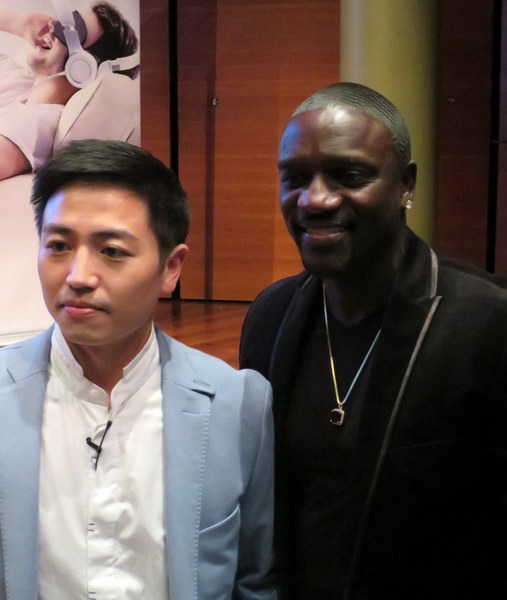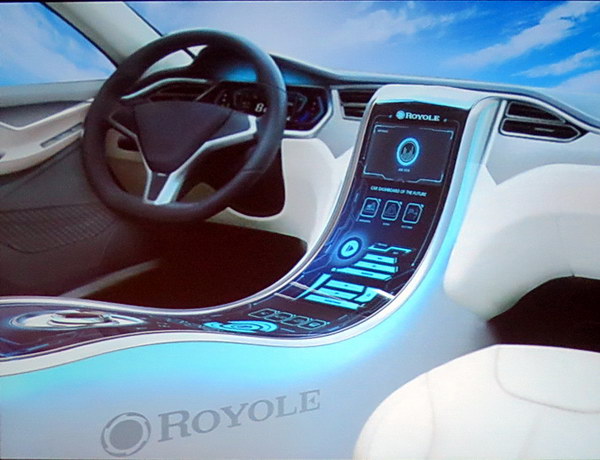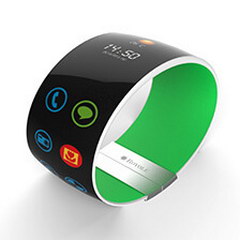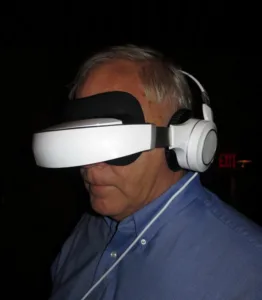In a press event just before Pepcom in New York on Thursday, September 15th, Dr. Bill Liu, Royole (pronounced “Royal”) founder and CEO, introduced Royole’s successor to the 2D Royole X (Subscription required) Virtual Mobile Theater, the 3D Royole Moon. This unit appears to be virtually identical to the Royole X head mounted display (HMD) except the system will show different views to each eye, enabling it to be used for viewing 3D movies and for 3D gaming. The (slightly) older unit would only show 2D images. The Moon was also shown later that evening at Pepcom (See related Display Daily –Hisense HDR and More at Pepcom) Royole has posted a promotional video on the Moon on YouTube.
The Moon uses two 3300 DPI OLED imagers, one for each eye. The resolution of each imager is 1080p (1920 x 1080). Since the Moon, like the Royole X, has a relatively narrow field of view (FOV), the pixels are small enough to be invisible and a smooth, non-pixelated image is seen. The virtual image is said to be 800” (20.3M) wide. Like the FOV, the distance to this virtual screen is not given. However, for pixels in 1920 pixel wide image to be invisible, the maximum FOV is 32° (16° half-angle), giving a minimum virtual screen distance of 1395” (35.4M).
Matt Brennesholtz testing the new Royole Moon
Like the Royole X, the Moon has multiple adjustments to fit the HMD to the wearer. While the unit cannot be worn with glasses, the focus adjustment of -7.00 to +2.00 diopters is sufficient so most people won’t need to wear their glasses. Left and right eye can be focused independently. There is also a interpupillary adjustment, presumably the same 56mm to 70mm as in the Royole X. (Full specifications for the Moon have not been released.) I couldn’t get the adjustment right to eliminate all vignetting of the displays while trying the Moon, even though the adjustment should be sufficient to accommodate most people including me.
The unit also allowed adjustment of the headset band length, the distance between the earphones and the HMD and the angle between the HMD support and the headband. Dr. Liu, when asked about the weight of the unit, declined to answer and just said that the adjustments made it possible to have no weight on the nose piece, a critical item for long-term comfort. In my case, I’m not sure this was true, since I could feel the nose piece squeezing my nose uncomfortably.
The Moon HMD has a wired connection to a small external controller unit designed to fit in the user’s pocket. The unit runs Moon OS, which is controlled by a touch screen panel located on the right earphone. For video and other content, the pocket unit has memory (16G in the base Moon unit. The premium versions of the Royole X have up to 64G) and both a wired (HDMI) connection and Wireless (802.11 b/g/n @ 2.4GHz in the Royole X) connections plus a micro USB connector. The micro USB connector supports USB On the Go and is also used to charge the 6000 mAh battery, said to give 5 to 7 hours of video playback in the Royole X.
The earphones in the Moon include active noise cancelling with 22dB of cancellation, eliminating more than 92% of external noise. Frequency response of the headphones is said to be 20Hz to 20KHz.
Like the Royole X, the Moon is not really immersive, with it’s small image size. The unit completely blocks vision, a requirement for immersion, but provides no input to your peripheral vision, another immersion requirement. The unit will not show VR 360° images since it has no motion sensors to detect when you move your head.
Dr. Liu also introduced Akon, an American singer, rapper, songwriter, businessman, record producer and actor, as Royole’s new Chief Creative Officer (CCO). Dr. Liu said, “His amazing gifts and talents in music, art, and business coincide with our innovative culture.”
 Dr. Liu, founder and CEO of Royole with R&B star Akon, the new CCO for the company.
Dr. Liu, founder and CEO of Royole with R&B star Akon, the new CCO for the company.
The Moon, like the Royole X, is based on the company’s 3,300 ppi flexible AMOLED material with a contrast ratio of 10,000 to 1 and a maximum brightness of 300 cd/m². This flexible material is based on printed electronics technology and, personally, I see OEM sales of the material as the future of the company, not a consumer HMD based on the material. At the press conference, Dr. Liu discussed other applications of the material, including a curved automotive dashboard. While 300 nits wouldn’t be bright enough for a automotive dashboard, this is probably not a fundamental limitation of the material itself. If it is, no doubt the company is working hard to improve the light output.

The company also says its flexible displays and flexible sensors (i.e. touch screen) can be combined into a Royole-patented “Smart Mobile Design.” The Royole touch screen can also be combined with Royole OLED displays or non-Royole LCD or OLED displays for conventional smartphones.

The Royole Moon 3D virtual mobile theater will be available online at www.royole.com starting September 23, 2016. It has an MSRP of $799.99. Moon will come in three colors: white, black and gold. The 2D Royole X is still available for $699. –Matthew Brennesholtz

